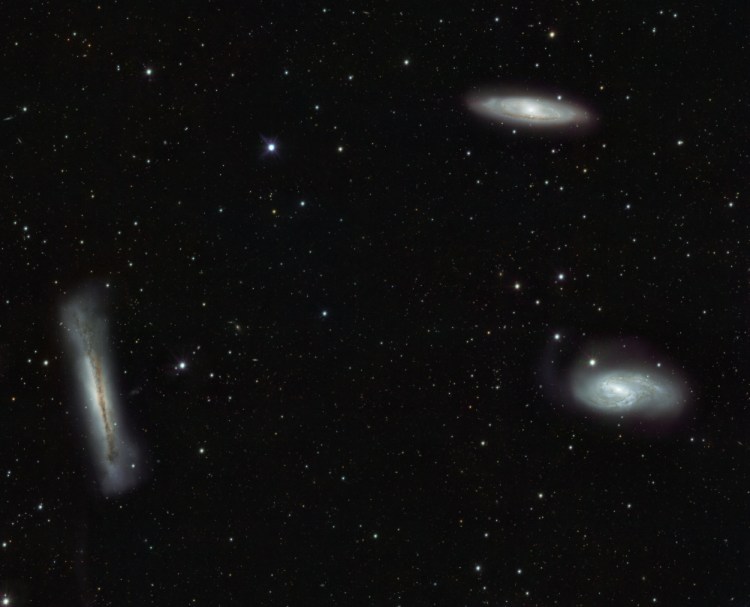One night last week I was making my way across the Arctic wasteland of my driveway and was startled to look up and see my old friend Leo.
Startled because this usually doesn’t happen until about mid-March — and going by the empirical facts (snowbanks 6 feet high and 6 degrees Fahrenheit out my kitchen window that morning), it was still February. But wait. The first day of spring already came and went?
Somehow winter has been in slow motion. But no matter what the cold and snow do to your mind, the sky keeps strictly to the schedule. Which probably explains why some subconscious part of my mind was so glad to see Leo. It really is getting on toward spring.
Leo, the Lion, has stalked the evening sky for months actually, but by around 10 p.m. in the middle of March, it dominates my southern treetops.
On a clear night, look south and you can pretty easily spot six bright stars roughly in the shape of an anvil. To the left at the narrow end is the bright star Denebola, our foreshortened version of the Arabic phrase dhanab al-asad, the lion’s tail. At the lower right of the anvil is Regulus, the brightest star in Leo. In the imagination’s star-lion, Regulus is at the joint of the front legs. Directly above Regulus is Eta Leonis (with no name of its own, oddly, just the Greek letter eta) in the lion’s chest, and above and slightly left is Algieba (al jabbah, the mane) at the shoulder.
If you track your eye above Algieba, you’ll see three more stars, not quite so bright, looping in a sort of backward question mark. These outline the lion’s head. Along the lion’s back, the star between Algieba and Denebola is Zosma, which sounds like a name out of some rambling fantasy trilogy and is actually a misapplied version of a Greek word for girdle. Arab astronomers more appropriately called it Al Thahr al Asad, the lion’s back.
If you imagine the sun traveling a great circle every year across the sky, that road — called the ecliptic — runs through the 12 constellations of the Zodiac (plus one other, Ophiuchus). Leo is one of the 12. To its east lies Virgo (still mostly down behind my trees on March evenings). To the west is Cancer, the Crab, made of four dimmer stars whose general location you can picture by the very bright object parked just in front of the lion’s face for now — Jupiter.
Like all the constellations, Leo also has a lot of interesting objects that you can’t see with your naked eye. But with a little help from the astronomers and their large telescopes and calculations, your mind’s eye can picture them.
Some are galaxies. About a third of the way from Regulus to Denebola and down a bit is the Leo I group of galaxies. They’re part of the Virgo Supercluster and are in the vicinity of 820,000 light-years from us, too faint to see without a telescope, of course. A little farther toward Denebola is the Leo Triplet group of galaxies, or M66 group, around 35 million light-years away.
Directly south of the Leo I group is the star Wolf 359, which also is invisible to us because it’s a red dwarf shining at a very dim magnitude 13.5. But it’s interesting to play with in thought because it’s the fifth-nearest star known, about 7.8 light-years away.
At the other extreme, Eta Leonis, bright in the anvil, is a supergiant far, far away, but so big we see it easily. The estimates vary, but this star is somewhere around 25 times as large as the sun and has a luminosity of 5,600 suns, or some think up to 9,500 suns. Robert Burnham, whose “Celestial Handbook” has a more or less scriptural presence among starwatchers, estimates it could be as luminous as 13,000 suns. Eta is somewhere between 1,300 and 1,800 light-years away from us. If it were 32.6 light-years from us (a standard used to compare stars’ brightnesses, called the absolute magnitude), it would outshine even Venus in the sky.
Southeast of Regulus is another supergiant you can see, Rho Leonis. Rho is estimated to be from 3,650 to 5,000 light-years away and has a luminosity of 165,000 or maybe up to 295,000 suns. To us it shines at magnitude 3.85, well within our naked-eye sight, but its absolute magnitude is probably around minus 5.7, even brighter than Eta.
One more for the road of your imagination: To the west of Regulus and slightly up is the star R Leonis, which sometimes you can pick out with your eye and other times you can’t. It’s not just your imagination. R Leonis is a variable star, meaning its brightness changes over time. In R Leonis’ case, the brightness changes radically over a long period of 312 days, from magnitude 5 — which you can see on a dark night if you know where to look — to magnitude 10.5, which is fainter than some of the galaxies in the Leo I and Triplet groups.
When I say Leo is an old friend, I’m speaking metaphorically, I guess. Every year, just as spring is breaking out of winter, this old friend appears like spring out of the driveway Arctic. Right there by the house.
Dana Wilde lives in Troy. His writings on the stars, planets and galaxies are collected in “Nebulae: A Backyard Cosmography,” and he is a contributor to “Pluto: New Horizons for a Lost Horizon” now available from North Atlantic Books. You can contact him at naturalist1@dwildepress.net. Backyard Naturalist appears the second and fourth Thursdays each month.
Send questions/comments to the editors.




Comments are no longer available on this story